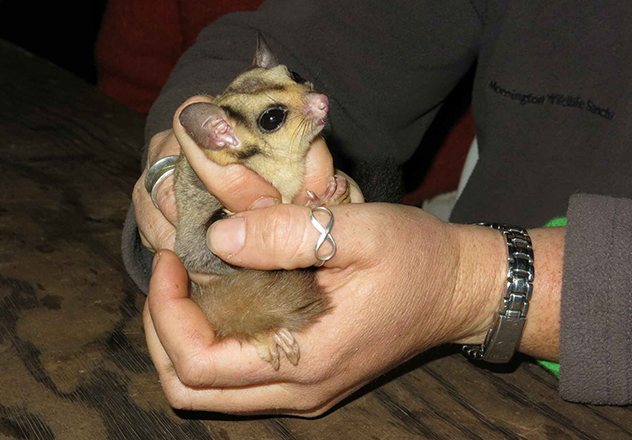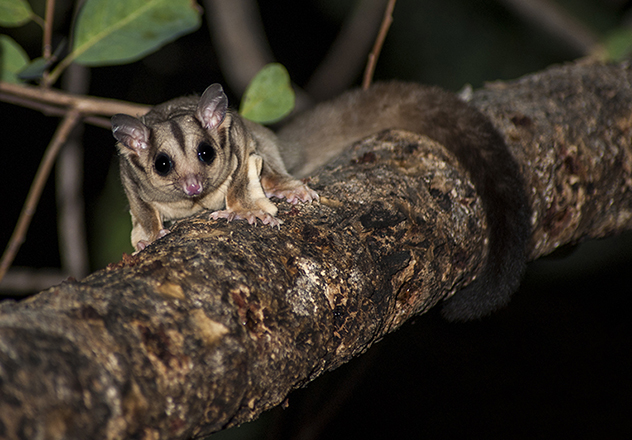Sugar Gliders are small possums with grey fur, which have the remarkable ability to glide from tree to tree using a gliding membrane which extends from their fifth finger to their ankle. Recent research has shown that gliders previously classified as Sugar Gliders actually belong to three different species.

 Jeanette Kemp/AWC
Jeanette Kemp/AWC
AWC protects Sugar Gliders at its sanctuaries and partnership areas by implementing fire management (prescribed burning), controlling or eradicating feral herbivores, and working to decrease the impact of feral cats through baiting and trapping.
 AWC
AWC
Habitat destruction and fragmentation are of particular concern to the species as this results in the decline of the number of available hollows. The Sugar Glider species was hard hit by the 2019/2020 bushfires, resulting in large-scale degradation of habitat.
Other threats include feral predators, such as cats and foxes, as well as the use of barbed-wire fences that can trap the animal’s gliding membrane.

Description
The Sugar Gliders’ fur is thick, soft, and is usually an ash-grey to brown-grey above, with a dark stripe that extends from the middle of the head to the mid-back region. The belly, throat and chest are cream in colour, and the bushy tail, which can average about 19cm, is darker and in some cases may have a white tip.
Sugar Gliders grow to be about 24 – 30cm in length, weighing up to 115 grams, and have a lifespan of up to 9 years.
When their legs are stretched out their patagium extends enabling them to glide up to 50 metres. When gliding they use their tail as a rudder to change direction and to stabilise their landing.
Ecology
The Sugar Glider active at night, sleeping by day in nests made of leaves in tree hollows. They are very social animals and live in family groups, with multiple adults accompanied by the young from that season. Both males and females engage in parental care. This arrangement allows one adult to keep the young warm in the hollow while the other parent is out foraging for food.
Sugar Gliders consume a wide variety of foods in their diet, feeding on nectar, pollen, seeds, insects and even on small birds and their eggs – mainly foraging in the lower layers of the forest canopy. Their insatiable appetite for all things sweet, Sugar Gliders are likely important pollinators of many Banksia species.
The Sugar Glider is also one of the largest marsupials that have been confirmed to enter torpor, a state similar to hibernation, in which an animal slows its breathing and dramatically reduces its physical activity for days or even weeks, dropping its body temperature and oxygen consumption and wrapping its body into a ball.
Sugar Gliders commonly give birth to twins, which remain in the pouch for just over two months. They then leave the nest to forage for food, usually with their mother. Females can produce two litters in a year.
Range and Abundance
Previously classified as a single widespread species (Petaurus breviceps), recent research has revealed that the Sugar Glider is actually three genetically distinct species: Petaurus breviceps and two newly identified species, Krefft’s glider (Petaurus notatus) and the Savanna Glider (Petaurus ariel).
When considered as one species, sugar gliders were widespread, abundant and officially classified as “least concern”. The distinction of these three species has resulted in a substantially smaller distributions for the Sugar Glider and Savanna Glider.
This reclassification means that the distribution of the Sugar Glider is substantially reduced, being limited to coastal regions in South-eastern Australia. The Savanna Glider lives in the tropical woodlands of northern Australia, where is range has contracted by 33% since the early 1990’s.
Help AWC protect Sugar Gliders from key threats like wildfires, feral herbivores and feral cats.
Donate nowAWC helps protect a population of Kangaroo Island Dunnarts on Kangaroo Island.
Koalas inhabit eucalypt forests and woodlands in eastern Australia from north Queensland through to south-east South Australia.